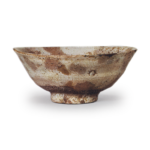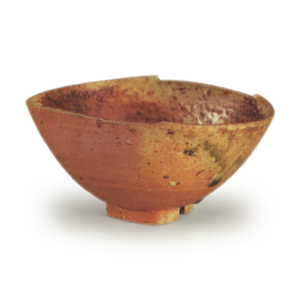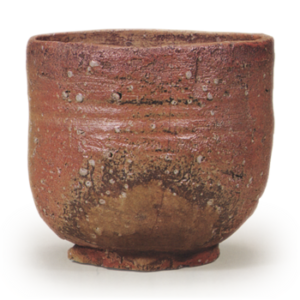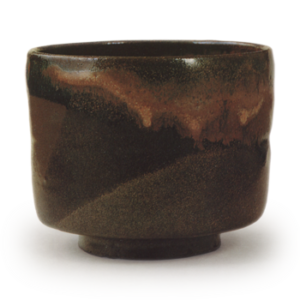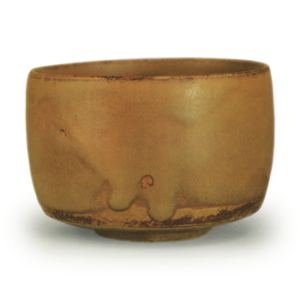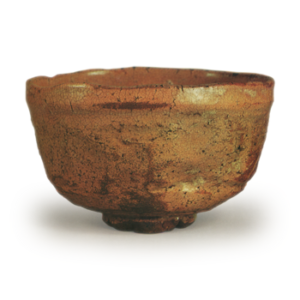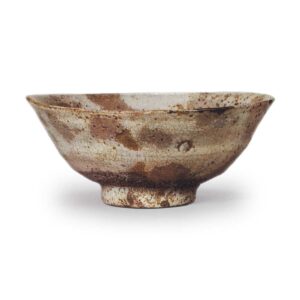
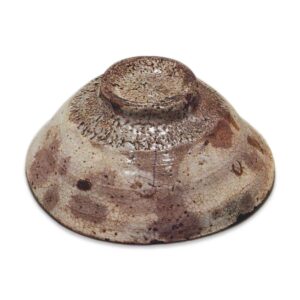
Collection: Nezu Museum
Height: 8.2cm
Diameter: 15.8cm
Outside diameter of foot ring: 5.5cm
Height of foot ring: 1.5cm
This tea bowl is so famous that the first thing that comes to mind when you hear the term “rain-leakage tea bowl” is this tea bowl. The name was given in reference to the stain (view) on this tea bowl, and is based on the poem by Fujiwara no Yoshikage “The rain leaking through the moth on the floor of the house in the countryside is a familiar sight”. Truly worthy of being called a representative masterpiece of rain leaks, it is a work that shows the full range of natural stain colors and variations, from dark to light, from light purple to light brown, both inside and out. The arrangement is also full of the kind of beauty that is difficult to achieve artificially. The tea aesthetic is overflowing.
The tea master’s sense of beauty is expressed in the way the tea bowl is made, the glaze, the marks left by the potter’s wheel, the foot ring, the side of the bowl, the glaze pool, the mottled glaze, the crackle, the shrinkage, the eyes, the fire marks, the hanging marks , finger marks, etc., and discover new beauty in them, but in addition to this, tea masters also carefully use their aesthetic sense to actively pick out so-called period beauty that has arisen in the course of the tea bowl’s acquired history, going beyond the scope of its innate beauty. The best example of this is rain leaks. The beauty of rain leaks, or stains, is something that Japanese people can easily understand intuitively, and there is a sense of beauty in this that is conveyed in phrases such as “The upper and lower parts of the robe are loose, and the mother-of-pearl inlay on the shaft is missing a piece of shell, and this is what makes it so meaningful” (Turezuregusa), but it is something that Japanese people are innately drawn to, and it is a kind of beauty that is not “well-balanced” (same as above), but rather a kind of beauty that is out of tune, or a kind of beauty that is out of tune. The way a tea master finds beauty in a leak in the roof is also based on the innate preferences of the Japanese.
The caterpillar is light and soft, and although it has a clay-like appearance, the glaze melts well, and the thin parts of the work are almost like old Katsute-dachi. Like well-known examples, it is unglazed, with a prominent wheel mark, a flared foot, and a bamboo-jointed foot ring. It is a small bowl, but there are many interesting features. Even if we ignore the leak, it is a fine bowl. The exterior has a rough lathe mark, and there are traces of the kiln fire on the body, as well as fine streaks from the slip. The glazed surface is soft and moist, and the craquelure is also rough. From the foot to the inside and outside of the foot ring, there is a magnificent pattern of mottled white and brown that looks like a well, and this is one of the main attractions of the tea bowl. However, the main attraction of this tea bowl is the appearance of various-sized raindrops on the surface of the glaze, which can be seen on the inside and outside of the bowl. The discovery of the charm of this accidental pattern, with its rich coloration, is a great achievement for the tea master. In a sense, this tea bowl is a “mushroom” that allows you to fully enjoy the late autumn tea ceremony to your heart’s content. There are four eyes on the front and a single vertical crack running from the center of the body to the front.
Inner box: “Mino-mushi” written on the lid by Matsudaira Fumai, “Koryo tea bowl Mino-mushi” written on the reverse of the lid by an unknown author, “Gesshōshū (collection of poems) Vol. 1: The rain that falls on the Mino-mushi forest in my hometown reminds me of the rain that falls on the boards of my house”
Outer box, silver powder lettering “Minomushi”
It was originally in the collection of the Aochi family in Asakusa, Edo, and in 1920 it was sold at auction by the Aochi family. It then came into the possession of Nezu Aoyama (Kaichiro), and in 1941, when the Nezu Museum was established, it became part of the museum’s collection, where it remains today.

